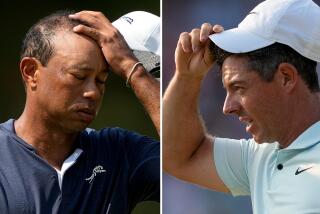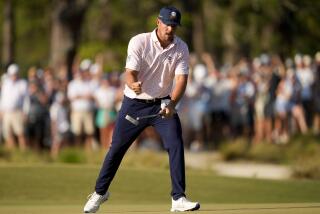Phil Mickelson, Billy Horschel up to par in U.S. Open

- Share via
ARDMORE, Pa. -- Difficult, the U.S. Golf Assn.’s Mike Davis said this week, is “our DNA.” And making a course play difficult, the USGA’s executive director said, is easy to do.
For proof, Davis offered Friday’s setup at Merion Golf Club, which played 95 yards shorter than its peak length and gave away only three completed rounds under par at the U.S. Open.
Was that Merion proving length doesn’t determine golf course difficulty, or the USGA proving it knows how to manipulate DNA?
Zach Johnson certainly had an opinion. The 2007 Masters champion told the Golf Channel that the setup “just enhances my disdain for the USGA and how it manipulates golf courses.”
Phil Mickelson and Billy Horschel enter Saturday’s third round as the only two players under par (at one-under 139), though more than 60 will return to complete their second rounds. That list includes Ian Poulter and amateur Cheng-Tsung Pan, who are even par, tied with Justin Rose, Steve Stricker and Luke Donald.
Mickelson, who shot a two-over 72, capped his round with his only birdie of the day at No. 18 after play was suspended. That left him in brighter spirits along with Horschel, whose 67 tied Mickelson’s first-round score as the tournament’s low round.
Horschel has made his personal battles with patience well known. Making four birdies on Friday’s demanding setup lifted his spirits.
“I’m trying to keep a smile on my face and be happy with anything I do,” said Horschel, winner of the Zurich Classic this year.
Otherwise, smiles were in short supply. Player after player said the most difficult obstacles they faced Friday were hole locations, which were decided by a group of USGA officials led by Davis.
Because Merion’s greens remained soft after Thursday’s rain, the USGA found corners and edges for holes that players thought inconceivable based on their practice rounds.
Twelve of the holes were located 15 feet or less from the edge of a green. The hole at No. 10, a drivable par-four, was tucked so far back it nearly reached Ardmore Road.
At No. 11, the right-side hole brought a creek very much into play. And the hole at No. 17 sat atop a ledge that dragged spinning shots down its false front. Rory McIlroy’s shot to 17 rolled back some 20 yards off the green, forcing him into a demanding par save.
“They put the pin in a place that’s virtually impossible to get to,” McIlroy said of 17. “I felt like I hit a career shot and hit it to about 60 feet.”
Tiger Woods, who said he liked his position at three over after a second-round 70, called some of the holes “severe.” Adam Scott, who made nine bogeys and a double on the day to fall to seven over, said good rounds remained possible. “You just have to hit every shot perfect,” the Masters champion said.
And Russell Knox, who shot 69 in the first round, might have been even more impressed with his second-round 75.
“It’s not often you flush it and shoot five over,” Knox said. “It was as tough a course as I’ve ever played.”
McIlroy (three over) insisted that the setup was fair and said the USGA could have made it more difficult — and still can this weekend. But firmer greens probably will produce less formidable hole locations, unless the USGA wishes to provoke a strike.
Davis reiterated this week that the USGA does not define the U.S. Open by score. Asked whether he believed that, Woods flatly said, “No.”
“They’re trying to protect par,” said Woods, who gave a terse explanation of his left-arm pain. “Watching the telecast, I hadn’t seen this many guys blow putts past the hole with bad speed. … They made it really hard. You’ve got to hit them in the right spots, but it’s not always easy to do with the wind blowing like this.”
Five holes (6, 9, 14, 15 and 18) produced more double bogeys than birdies. Players made 10 double bogeys at the par-four 18th and only seven birdies. One of those was Mickelson’s.
His round was a fit of missed opportunities and awkward irons off the tee, but Mickelson persevered through a string of frustrations. He made back-to-back bogeys at 12 and 13 but played Merion’s ornery “Back Five” stretch at one under.
A twilight par save at 17 set up Mickelson’s finish, a bouncing birdie putt that pushed him to red numbers once again.
“It felt great,” said Mickelson, who has five runner-up finishes at the U.S. Open. “I wasn’t expecting birdie there.”
The USGA has a history of alienating the tortured souls who play its championships for money and appears to be doing so again this week.
“The scores we shoot are much more reflective on the setup of the golf course,” said Jim Furyk, the 2003 Open champion, who missed the cut after rounds of 77-79. “You could set Merion up to where 10 under par would win, and you could set Merion up where 20 over would win. It all depends on how they set up the golf course.”
More to Read
Go beyond the scoreboard
Get the latest on L.A.'s teams in the daily Sports Report newsletter.
You may occasionally receive promotional content from the Los Angeles Times.










